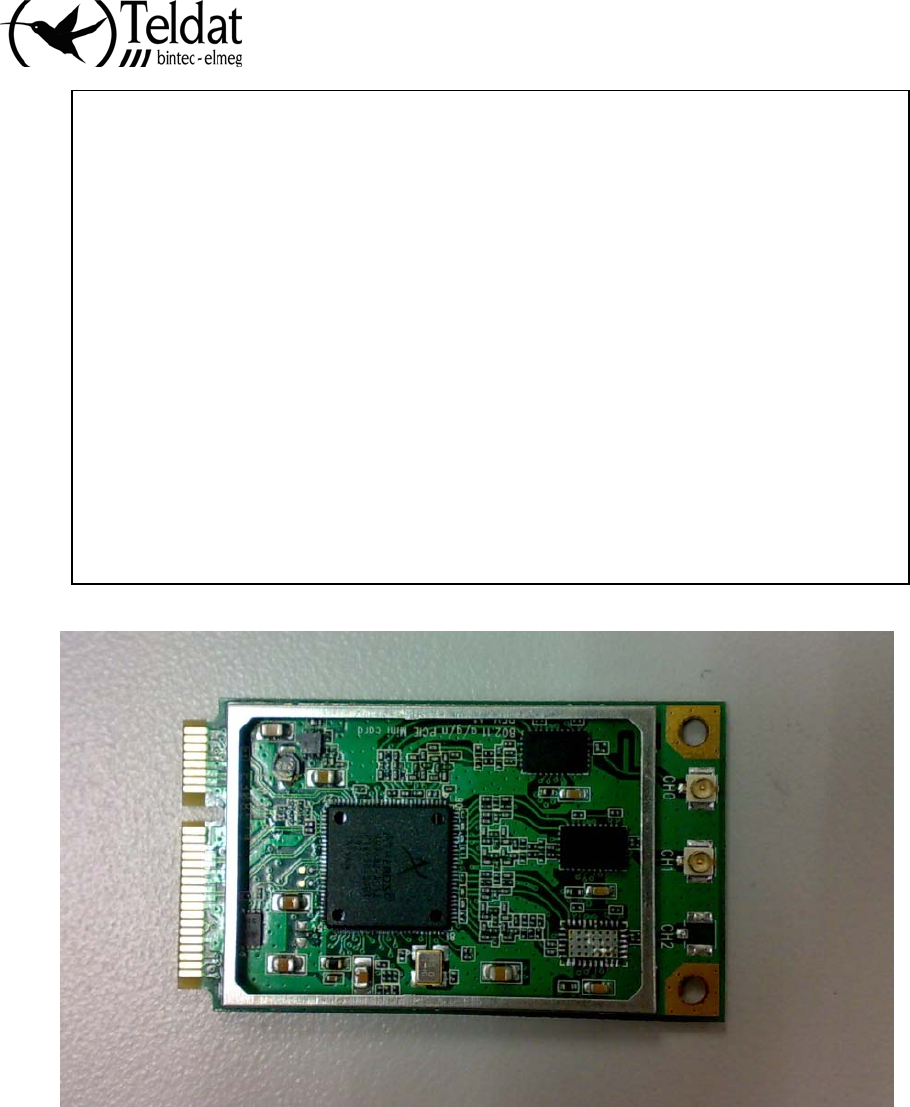User Manual

User Manual
for
IEEE 802.11 a/b/g/n , AR9382 SoC , 2T2R , FMC
Model Number : WMCND03TD
Revision: 1.0
This document contains confidential proprietary information and is the property of Alpha Networks Inc.. The contents of
this document may not be disclosed to unauthorized persons without the written consent of Alpha Networks Inc..

Alpha Networks Proprietary and Confidential Information
ii
Revision History
Rev. Date Author Reason for Changes
1.0 2010/12/22 Amanda Wang New released – Tx Output Power & Rx Sensitivity update based
on ES ver. 0A1
Alpha Networks Proprietary and Confidential Information
iii
Contents
1.0 SCOPE........................................................................................................................................................................... 5
1.1 DOCUMENT................................................................................................................................................................. 5
1.2 PRODUCT FEATURES.................................................................................................................................................. 5
2.0 REQUIREMENTS ....................................................................................................................................................... 5
2.1 GENERAL REQUIREMENTS................................................................................................................................... 6
2.1.1 IEEE 802.11a Section.......................................................................................................................................... 6
2.1.2 IEEE 802.11b Section.......................................................................................................................................... 7
2.1.3 IEEE 802.11g Section.......................................................................................................................................... 7
2.1.4 IEEE 802.11n Section for 2.4GHz band.............................................................................................................. 8
2.1.5 IEEE 802.11n Section for 5GHz band................................................................................................................. 9
2.1.6 General Section ................................................................................................................................................. 10
2.2 SOFTWARE REQUIREMENTS.................................................................................................................................... 11
2.2.1 Information........................................................................................................................................................ 11
2.2.2 Configuration .................................................................................................................................................... 11
2.2.3 Security.............................................................................................................................................................. 11
2.3 MECHANICAL REQUIREMENTS ............................................................................................................................... 12
2.4 COMPATIBILITY REQUIREMENTS ........................................................................................................................... 12
2.5 REQUIREMENTS OF RELIABILITY, MAINTAINABILITY AND QUALITY................................................................... 12
2.6 ENVIRONMENTAL REQUIREMENTS ......................................................................................................................... 12
Alpha Networks Proprietary and Confidential Information
5
1.0 Scope
1.1 Document
This document is to specify the product requirements for 802.11a/b/g/n Draft 2.0 2x2 DB PCI Express Mini Card.
This Mini Card is based on Atheros chipset that complied with IEEE 802.11n Draft from 2.4/5GHz, and it is also
backward compatible to comply with IEEE 802.11g and IEEE 802.11b standard to connect your exist 802.11 b/g
wireless LAN device.
1.2 Product Features
Compatible with IEEE 802.11a high rate standard to provide wireless 54Mbps data rate
Compatible with IEEE 802.11g high rate standard to provide wireless 54Mbps data rate
Compatible with IEEE 802.11b high rate standard to provide wireless 11Mbps data rate
Compatible with IEEE 802.11n draft 2.0 standard to provide wireless 300Mbps data rate
Operation at 2.4 ~ 2.5GHz and 5.15~5.85GHz frequency band to meet worldwide regulations
Dynamic frequency selection (DFS) in required 5-GHz bands
Dynamic date rate scaling at 6, 9, 12, 18, 24, 36, 48, 54Mbps for IEEE 802.11g
Dynamic date rate scaling at 1, 2, 5.5, and 11Mbps for IEEE 802.11b
Dynamic date rate scaling at 6, 6.5, 13, 13.5, 19.5, 26, 27, 39, 40.5, 53, 54, 58.5, 65, 78, 81, 104, 108, 117,
121.5, 130, 135, 162, 216, 243, 270, 300Mbps for IEEE 802.11n
2x2 MIMO Spatial steaming simultaneously to improve highest throughput performance and extended
coverage
Data rates up to 300Mbps @ 11n 40MHz channels operation
Supports infrastructure networks via Access Point and ad-hoc network via peer-to-peer communication
Supports WEP, 802.1x, WPA and WPA2 enhanced security
Drivers support Windows 2K, XP and Vista
Advanced Wireless multimedia QoS enhancement
Full-size PCI-E Express 1.1 interface compliance
RoHS compliant
Tx Beamforming (Tx BF) support
2.0 Requirements
The following sections identify the detailed requirements of the 802.11a/b/g/n Draft 2.0 PCI Express Mini Card.

Alpha Networks Proprietary and Confidential Information
6
2.1 General Requirements
2.1.1 IEEE 802.11a Section
# Feature Detailed Description
2.1.1.1 Standard IEEE 802.11a
2.1.1.2 Radio and
Modulation Type
BPSK, QPSK, 16QAM, 64QAM, OFDM
2.1.1.3 Operating
Frequency
5.15 ~ 5.35GHz. , 5.47 ~ 5.725GHz and 5.725~5.850
GHz for US and Canada
5.15 ~ 5.35GHz and 5.47~5.725GHz for Japan
5.15 ~ 5.35GHz and 5.47 ~ 5.725GHz for Europe
5.725~5.850GHz for China
2.1.1.4 Channel Numbers 24 non-overlapping channels for US and Canada
19 non-overlapping channels for Japan
19 non-overlapping channels for Europe
5 non-overlapping channels for China
2.1.1.5 Data Rate 54, 48, 36, 24, 18, 12, 9, and 6Mbps
2.1.1.6 Media Access
Protocol
CSMA/CA with ACK
2.1.1.7 Transmitter Output
Power
Frequency 5150 ~5250MHz
IEEE 802.11a: 16.78dBm
Frequency 5250 ~5350MHz
IEEE 802.11a: 23.73dBm
Frequency 5470 ~5725MHz
IEEE 802.11a: 23.73dBm
Frequency 5725 ~5850MHz
IEEE 802.11a: 24.23dBm
2.1.1.8 Receiver Sensitivity
Typical Sensitivity at Which Frame (1000-byte PDUs)
Error Rate < 10% at room temperature 25 degree C.
–87dBm at 6Mbps
–87dBm at 9Mbps
–86dBm at 12Mbps
–84dBm at 18Mbps
–80dBm at 24Mbps
–77dBm at 36Mbps
–74dBm at 48Mbps
–72dBm at 54Mbps

Alpha Networks Proprietary and Confidential Information
7
2.1.2 IEEE 802.11b Section
# Feature Detailed Description
2.1.2.1 Standard IEEE 802.11b
2.1.2.2 Radio and
Modulation
Schemes
DQPSK, DBPSK, DSSS, and CCK
2.1.2.3 Operating
Frequency
2400 ~ 2497MHz ISM band
2.1.2.4 Channel Numbers 11 channels for United States
13 channels for Europe Countries
14 channels for Japan
2.1.2.5 Data Rate 11, 5.5, 2, and 1Mbps
2.1.2.6 Media Access
Protocol
CSMA/CA with ACK
2.1.2.7 Transmitter Output
Power
Frequency 2400~2483.5MHz
IEEE 802.11b: 20.50dBm
2.1.2.8 Receiver Sensitivity
Typical Sensitivity at Which Frame (1000-byte PDUs) Error Rate =
8%
–95dBm at 1Mbps
–93dBm at 2Mbps
–92dBm at 5.5Mbps
–88dBm for 11Mbps
2.1.3 IEEE 802.11g Section
# Feature Detailed Description
2.1.3.1 Standard IEEE 802.11g
2.1.3.2 Radio and
Modulation Type
BPSK, QPSK, 16QAM, 64QAM with OFDM
2.1.3.3 Operating Frequency
2400 ~ 2483.5MHz ISM band
2.1.3.4 Channel Numbers 11 channels for United States
13 channels for Europe Countries
13 channels for Japan
2.1.3.5 Data Rate 6,9,12,18,24,36,48,54Mbps
2.1.3.6 Media Access
Protocol
CSMA/CA with ACK
2.1.3.7 Transmitter Output
Power
Frequency 2400~2483.5MHz
IEEE 802.11g: 19.47dBm
2.1.3.8 Receiver Sensitivity
Typical Sensitivity at Which Frame (1000-byte PDUs) Error Rate =
10%
–88dBm at 6Mbps
–88dBm at 9Mbps
–88dBm at 12Mbps
–88dBm at 18Mbps
–87dBm at 24Mbps
–83dBm at 36Mbps
–76dBm at 48Mbps
–74dBm at 54Mbps

Alpha Networks Proprietary and Confidential Information
8
2.1.4 IEEE 802.11n Section for 2.4GHz band
# Feature Detailed Description
2.1.4.1 Standard IEEE 802.11n
2.1.4.2 Radio and
Modulation Type
BPSK, QPSK, 16QAM, 64QAM with OFDM
2.1.4.3 Operating Frequency
2.4 ~ 2.5GHz frequency
2.1.4.4 Channel Numbers 11 channels for United States
13 channels for Europe Countries
13 channels for Japan
2.1.4.5 Data Rate From MCS – 0 to MCS –15 as shown in Appendix I
2.1.4.6 Media Access
Protocol
CSMA/CA with ACK
2.1.4.7 Transmitter Output
Power
Frequency 2400~2483.5MHz
IEEE 802.11n MCS0 20MHz: 18.73dBm
IEEE 802.11n MCS0 40MHz: 18.73dBm
2.1.4.8 Receiver Sensitivity
Typical Sensitivity at Which Frame (1000-byte PDUs) Error Rate =
10%
HT20
–88dBm at MCS0
–88dBm at MCS1
–87dBm at MCS2
–82dBm at MCS3
–80dBm at MCS4
–75dBm at MCS5
–73dBm at MCS6
–71dBm at MCS7
HT40
–85dBm at MCS0
–85dBm at MCS1
–85dBm at MCS2
–81dBm at MCS3
–78dBm at MCS4
–73dBm at MCS5
–70dBm at MCS6
–68dBm at MCS7

Alpha Networks Proprietary and Confidential Information
9
2.1.5 IEEE 802.11n Section for 5GHz band
# Feature Detailed Description
2.1.5.1 Standard IEEE 802.11n draft 2.0
2.1.5.2 Radio and
Modulation Type
BPSK, QPSK, 16QAM, 64QAM , and OFDM
2.1.5.3 Operating Frequency
5.15 ~ 5.35GHz. , 5.47 ~ 5.725GHz and 5.725~5.850 GHz for US
and Canada
5.15 ~ 5.35GHz and 5.47~5.725GHz for Japan
5.15 ~ 5.35GHz and 5.47 ~ 5.725GHz for Europe
5.725~5.850GHz for China
2.1.5.4 Data Rate From MCS – 0 to MCS –15 as shown in Appendix I
2.1.5.5 Media Access
Protocol
CSMA/CA with ACK
2.1.5.6 Transmitter Output
Power
Frequency 5150-5250MHz
IEEE 802.11n MCS0 20MHz: 16.87dBm
IEEE 802.11n MCS0 40MHz: 16.41dBm
Frequency 5250-5350MHz
IEEE 802.11n MCS0 20MHz: 23.92dBm
IEEE 802.11n MCS0 40MHz: 23.66dBm
Frequency 5470-5725MHz
IEEE 802.11n MCS0 20MHz: 23.75dBm
IEEE 802.11n MCS0 40MHz: 23.85dBm
Frequency 5725-5850MHz
IEEE 802.11n MCS0 20MHz: 23.98dBm
IEEE 802.11n MCS0 40MHz: 24.08dBm
Note: The maximum RF output power setting is different by channel and
individual country regulations.
2.1.5.7 Receiver Sensitivity Typical Sensitivity at Which Frame (1000-byte PDUs) Error Rate =
10%
HT20
–88dBm at MCS0
–87dBm at MCS1
–85dBm at MCS2
–82dBm at MCS3
–79dBm at MCS4
–76dBm at MCS5
–73dBm at MCS6
–71dBm at MCS7
HT40
–85dBm at MCS0
–85dBm at MCS1
–81dBm at MCS2
–78dBm at MCS3
–74dBm at MCS4
–71dBm at MCS5
–68dBm at MCS6
–66dBm at MCS7

Alpha Networks Proprietary and Confidential Information
10
2.1.6 General Section
# Feature Detailed Description
2.1.6.1 Antenna Connector
UFL (i-pex)antenna connectors
2.1.6.2 Operating Voltage
3.3VDC +/- 10%
2.1.6.3 Current
Consumption
470 mA at continuous transmit mode (2 Tx chains on )
250 mA at continuous receive mode (2 Rx chains on )
2.1.6.4 Form Factor and
Interface
PCI Express 1.1 Mini Card add-in card Form factor

Alpha Networks Proprietary and Confidential Information
11
2.2 Software Requirements
The Configuration Software supports Microsoft Windows 2000, XP and Vista. This configuration software includes
the following functions:
Information
Information allows you to monitor network status.
Configuration
Configuration allows you to configure parameters for wireless networking.
Security
Supports enhanced security WEP, 802.1x, WPA and WPA2.
2.2.1 Information
# Feature Detailed Description
2.2.1.1 General
Information
General Information shows the name of Wireless
Adapter, Adapter MAC Address, Regulatory Domain,
Firmware Version, and Utility Version.
2.2.1.2 Current Link
Information
Current Link Information shows the Current Setting
ESSID, Channel Number, Associated BSSID, Network
Type, Security Status, Link Status, Transmit Speed,
Signal Strength, and Link Quality.
2.2.1.3 Site survey To search the neighboring access points and display the
information of all access points.
2.2.2 Configuration
# Feature Detailed Description
2.2.2.1 ESS ID Input an SSID number if the roaming feature is enabled
Supports for ASCII printable characters.
2.2.2.2 Network Type Ad-hoc Mode and 802.11 Ad-hoc Mode for network
configurations that do not have any access points
Infrastructure Mode for network configurations with
access points
2.2.2.3 Power Save Extend the battery life of clients by allowing the client
to sleep for short periods of time while the Access Point
buffers the messages.
2.2.2.4 RTS Threshold
Set the number of bytes used for fragmentation
boundary for messages
2.2.2.5 Fragment
Threshold
Set the number of bytes used for RTS/CTS boundary
2.2.2.6 Transmission Speed
This indicates the communication rates. Select
appropriate transmission speed to match your wireless
LAN settings
2.2.2.7 Roaming Support Automatic or Manual Rescan to associate with
access point.
2.2.3 Security
# Feature Detailed Description
2.2.3.1 Encryption RC4 encryption algorithm
Support 64-bit and 128-bit WEP encryption
Support open system (OSA) and shared key
authentication (SKA)
2.2.3.2 WEP Management Four WEP keys can be selected
STA with WEP off will never associate an
y
AP with

Alpha Networks Proprietary and Confidential Information
12
# Feature Detailed Description
WEP enabled
WEP Key Format: Option for Hex format
2.2.3.3 802.1x Support EAP-TLS, EAP-TTLS, and EAP-PEAP
2.2.3.4 WPA/WPA2 Support WPA/WPA2-PSK and WPA/WPA2-EAP
Support Cipher Mode AES and TKIP
2.3 Mechanical Requirements
# Feature Detailed Description
2.3.1 Length 50.95mm
2.3.2 Width 30mm
2.3.3 Height 1.25mm
2.4 Compatibility Requirements
This device passes the following compatibility requirements.
# Feature Detailed Description
2.4.1 Wi-Fi Meet Wi-Fi certification for IEEE 802.11 product
2.4.2 WHQL Meet applicable WHQL certification requirements
2.4.3 Physical Layer and
Functionality
Meet ALPHA Engineering Test Plan and Test Report
2.5 Requirements of Reliability, Maintainability and Quality
# Feature Detailed Description
2.5.1 MTBF Mean Time Between Failure > 30,000 hours
2.5.2 Maintainability
There is no scheduled preventive maintenance required
2.5.3 Quality The product quality is followed-up by ALPHA factory
quality control system
2.6 Environmental Requirements
# Feature Detailed Description
2.6.1 Operating
Temperature
Conditions
The product is capable of continuous reliable operation
when operating in ambient temperature of 0 ℃ to +40℃.
2.6.2 Non-Operating
Temperature
Conditions
Neither subassemblies is damaged nor the operational
performance is degraded when restored to the operating
temperature after exposing to storage temperature in the
range of –20 ℃ to +75 ℃.
2.6.3 Operating
Humidity
conditions
The product is capable of continuous reliable operation
when subjected to relative humidity in the range of 10%
and 90% non-condensing.
2.6.4 Non-Operating
Humidity
Conditions
The product is not damaged nor the performance is
degraded after exposure to relative humidity ranging
from 5% to 95% non-condensing
Alpha Networks Proprietary and Confidential Information
13
FCC Statement:
Federal Communication Commission Interference Statement
This equipment has been tested and found to comply with the limits for a Class B digital device, pursuant
to Part 15 of the FCC Rules. These limits are designed to provide reasonable protection against harmful
interference in a residential installation. This equipment generates, uses and can radiate radio frequency
energy and, if not installed and used in accordance with the instructions, may cause harmful interference
to radio communications. However, there is no guarantee that interference will not occur in a particular
installation. If this equipment does cause harmful interference to radio or television reception, which can be
determined by turning the equipment off and on, the user is encouraged to try to correct the interference by
one of the following measures:
● Reorient or relocate the receiving antenna.
● Increase the separation between the equipment and receiver.
● Connect the equipment into an outlet on a circuit different from that to which the receiver is connected.
● Consult the dealer or an experienced radio/TV technician for help.
FCC Caution: Any changes or modifications not expressly approved by the party
responsible for compliance could void the user’s authority to operate this equipment.
This device complies with Part 15 of the FCC Rules. Operation is subject to the following two conditions: (1) This
device may not cause harmful interference, and (2) this device must accept any interference received, including
interference that may cause undesired operation.
For product available in the USA/Canada market, only channel 1~11 can be operated.
Selection of other channels is not possible.
This device and its antenna(s) must not be co-located or operation in conjunction with any other antenna or
transmitter.
IMPORTANT NOTE:
FCC Radiation Exposure Statement:
This equipment complies with FCC radiation exposure limits set forth for an uncontrolled environment. This
equipment should be installed and operated with minimum distance 20cm between the radiator & your
body.
This device is going to be operated in 5.15~5.25GHz frequency range, it is restricted in indoor environment only.
Devices will not permit operations on channels 120-132 for 11a and 11n/a which overlap the 5600 - 5650 MHz band.
Alpha Networks Proprietary and Confidential Information
14
IMPORTANT NOTE:
This module is intended for OEM integrator. The OEM integrator is still responsible for the FCC
compliance requirement of the end product, which integrates this module.
20cm minimum distance has to be able to be maintained between the antenna and the users for the host
this module is integrated into. Under such configuration, the FCC radiation exposure limits set forth for an
population/uncontrolled environment can be satisfied.
Any changes or modifications not expressly approved by the manufacturer could void the user's authority
to operate this equipment.
USERS MANUAL OF THE END PRODUCT:
In the users manual of the end product, the end user has to be informed to keep at least 20cm separation
with the antenna while this end product is installed and operated. The end user has to be informed that the
FCC radio-frequency exposure guidelines for an uncontrolled environment can be satisfied. The end user
has to also be informed that any changes or modifications not expressly approved by the manufacturer
could void the user's authority to operate this equipment. If the size of the end product is smaller than
8x10cm, then additional FCC part 15.19 statement is required to be available in the users manual: This
device complies with Part 15 of FCC rules. Operation is subject to the following two conditions: (1) this
device may not cause harmful interference and (2) this device must accept any interference received,
including interference that may cause undesired operation.
LABEL OF THE END PRODUCT:
The final end product must be labeled in a visible area with the following " Contains TX FCC ID:
YUAWMCND03TD ". If the size of the end product is larger than 8x10cm, then the following FCC part
15.19 statement has to also be available on the label: This device complies with Part 15 of FCC rules.
Operation is subject to the following two conditions: (1) this device may not cause harmful interference and
(2) this device must accept any interference received, including interference that may cause undesired
operation.